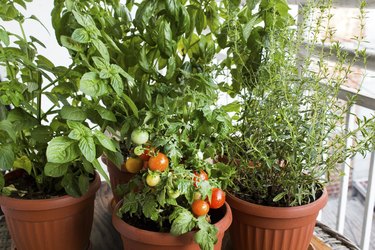
They're both warm-weather plants that do well in containers — growing basil (Ocimum spp.) and tomatoes (Lycopersicon esculentum, USDA zones 10-11) in the same container is not just possible, but it's also a good idea. Basil and tomatoes are natural companions, having similar requirements for light, soil, temperature and water. Basil may also help to repel harmful pests. You can grow your basil and tomatoes in the same container or in hanging baskets, and your efforts will be rewarded deliciously.
Tip
Not only can you grow basil and tomatoes in the same container, but planting these salad staples together can actually benefit them both.
Video of the Day
Planting and Care
Use a large container, at least 12 inches deep, for your basil and tomatoes — something the size of a 5-gallon bucket is ideal. Avoid clay pots, which dry out quickly. Attractive and inexpensive plastic pots are a better choice. You will need 2 to 3 pounds of high-quality commercial potting mix for cherry tomatoes and a basil plant; if you are growing a larger variety of tomato with your basil, use 5 to 7 pounds. Provide proper drainage by making sure there are ample holes at the bottom of the container.
Video of the Day
Make sure that the plants will get enough light by placing the container in an area that receives eight hours of full sun a day. Protect plants by waiting until night temperatures stay reliably over 60 degrees Fahrenheit before starting your container gardening outdoors. If the temperature falls below 55 F at night after a series of warm spring days, the tomato can suffer blossom drop. Basil is also extremely intolerant of cold temperatures and can be killed by a mere touch of frost.
Prevent root rot by poking your finger 1 to 2 inches into the soil and only watering if the soil feels dry. Another reason to avoid overwatering is that too much water can hurt the flavor of the basil. Once a month during the growing season, use a fertilizer high in phosphorus; a 5-10-10 formulation is optimal.
Growing Basil Varieties
If you are a novice at growing basil, you may want to start with sweet basil. This is the easiest variety to grow, and one that will impart a particularly sweet and mellow taste to its companion tomatoes.
For an attractive basil plant that you can use in Asian recipes, try a Thai basil such as Siam Queen. For classic Italian basil perfect for making pesto, plant Genovese basil, which grows particularly well in pots. The Sweet Dani variety of basil has a delicate lemon scent and flavor. The Purple Ruffles or Red Rubin varieties can be slightly bitter, but some people like the tart quality, and the leaves make a vivid and attractive garnish in salads.
Growing Tomato Varieties
For delicious cherry tomatoes that thrive in containers, plant the Tiny Tim cultivar, which produces fruit in 45 days. Cherry Gold, a yellow-gold version of the Tiny Tim, is also a good choice. The Red Robin, which will produce in 55 days, is a super-dwarf plant that doesn't exceed 6 inches tall. The Yellow Canary cultivar is similar to the Red Robin but for its yellow fruit, while the Patio Hybrid is a larger plant with relatively sizable, abundant fruit.
Since these tomato plants are of the determinate variety — meaning their growth stops at a certain point — it is not necessary to prune them.